Russian actor Ivan Mozzhukhin (1889-1939) was a legendary star of the European silent film. He escaped from execution by the Soviet Red Army and made a stellar career in Europe, but he suffered in Hollywood.
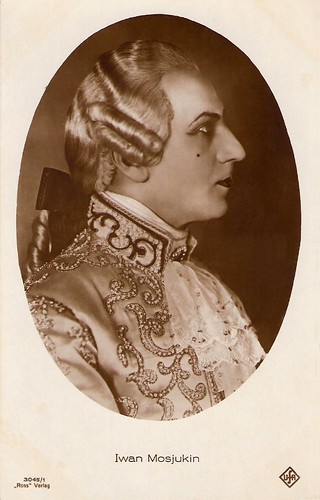
German postcard by Ross Verlag, no. 3948/1, 1928-1929. Photo: Ufa. Ivan Mozzhukhin in Casanova (Alexandre Volkoff, 1927).

German postcard by Ross Verlag. no. 1064/3, 1927-1928. Photo: DeWesti Film-Verleih. Ivan Mozzhukhin in Kean ou désordre et génie/Edmund Kean: Prince Among Lovers (Alexandre Volkoff, 1924).
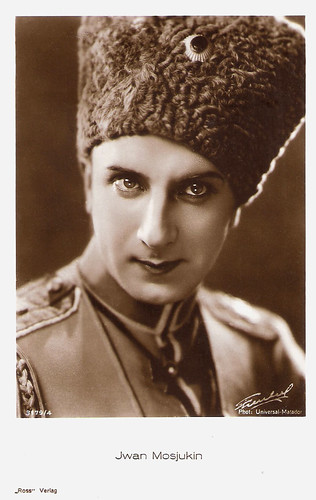
German postcard by Ross Verlag, no. 3179/4, 1928-1929. Photo: Freulich / Universal / Matador. Ivan Mozzhukhin in Surrender (Edward Sloman, 1927).

Austrian postcard by Iris Verlag, no. 5435. Photo: Lux-Film Verleih (Austrian distributor for German film companies, such as Greenbaum-Film, for which Mozzhukhin did various German films). Probably Ivan Mozzhukhin in Der geheime Kurier/The Secret Courier (Gennaro Righelli, 1928), a Greenbaum production.

Austrian postcard by Iris Verlag, no. 5497 Photo: Lux Verleih / G.
Ivan Ilyitch Mozzhukhin (Иван Ильич Мозжухин in Russian, or Iwan Mosjukin, as he was called in Germany, or Ivan Mosjoukine in France) was born in the village of Kondol, Saratov province, Russian Empire (now Penza province, Russia) in 1889.
His father was general manager of the large estate of Prince Obolensky. Mozzhukhin attended a Gymnasium in Penza, then studied law at the Moscow State University for two years.
At the university, he was active in amateur stage productions. Still a teenager, he joined the popular traveling troupe led by Petr Zarechny. Mozzhukhin became romantically involved with an actress from the troupe, Olga Bronitskaya (born Telegina), Zarechny's sister.
In 1908 she gave birth to their illegitimate son Aleksandr who was registered as the son of Petr Zarechny under his official family name. Thus the boy was raised as Aleksandr Petrovich Telegin, although he was made aware of his real father. According to Telegin, his father always supported them by sending letters, money, and packages until his name came under a ban in the Soviet Union.
Mozzhukhin returned to Moscow where he was a member of the Vvedensky Narodny Dom Theatre. In 1908, Mozzhukhin also made his film debut.
From 1911 to 1914 he worked in the silent films of producer Aleksandr Khanzhonkov. Mozzhukhin shot to fame after his leading role as violinist Trukhachevsky in The Kreutzer Sonata/Kreitzerova sonata (Pyotr Chardynin, 1911), based on the eponymous story by Leo Tolstoy.
He starred as Admiral Kornilov in Oborona Sevastopolya/Defence of Sevastopol (Vasili Goncharov, Aleksandr Khanzhonkov, 1911). This was the first film ever that was shot by two cameras. Next, he appeared in the delightful comedy Domik v Kolomne/The Kolomna House (Pyotr Chardynin, 1913) after a poem by Alexander Pushkin.
He would star in about thirty more silent Russian films made by Chardynin, Khanzhyonkov, and Yevgeni Bauer. His film partners were Diaghilev's ballerina Vera Karalli and his wife Natalya Lyssenko, billed in France as Nathalie Lissenko.

Russian postcard by A. Gornštein, Moscow, 1911.
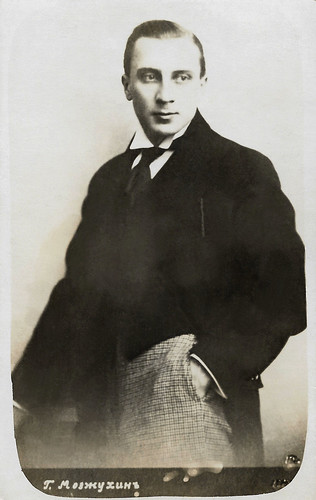
Russian postcard, no. 1011.

Russian postcard. Collection: Didier Hanson. A Who is Who of the Russian silent cinema. From left to right: Vitold Polonsky, Vladimir Maksimov, Vera Kholodnaya, Ossip Runitsch (in the back), Petr Cardynin, Ivan Khudoleyev, and Ivan Mozzhukhin.

Dutch postcard. Photo: Ivan Mozzhukhin in Pikovaya dama/Pique Dame (Yakov Protazanov, 1916).

Dutch postcard by De Rolprent. Photo: publicity still for Manolescu - Der König der Hochstapler/Manolescu (Victor Tourjansky, 1929) with Dita Parlo.
By the mid-1910s, Ivan Mozzhukhin had become the indisputable leading star of the Russian cinema. His facial expressions were studied by many actors and directors as exemplary acting masks.
From 1915 till 1919 he worked in about 40 films by directors Yakov Protazanov and Viktor Tourjansky under the legendary Russian producer Joseph N. Ermolieff.
His best-known films of this period were Pikovaya dama/The Queen of Spades (Yakov Protazanov, 1916) after Pushkin, Nikolay Stavrogin (Yakov Protazanov, 1915) after Fyodor Dostoyevsky, and Otets Sergiy/Father Sergius (Yakov Protazanov, Alexandre Volkoff, 1917).
The reviewer at IMDb writes that Otets Sergiy/Father Sergius "has many uncommonly modern characteristics. Besides the daring subject, it has a rather strongly developed lead character, good storytelling and cinematography, and a script which deals with human emotions without being exploitative or sentimental. Altogether it has a very modern touch to it for a movie made in 1917, (...) a prime example of the art film movement of pre-soviet Russia."
Mozzhukhin's incredible popularity brought him significant wealth, that came with attendant pressure. He also became famous for his numerous love affairs with his admirers.

French postcard by Cinémagazine no. 169. Mozzhukin played the male lead of prince Roundghito-Sing in Le lion des Mogols/The Lion of the Moguls (Jean Epstein, 1924). While the Moghol empire is falling apart, prince Roundghito-Sing decides to leave and make films in Paris, where he falls for the attractions of the city.

German postcard by Ross Verlag, no. 1066/1, 1927-1928. Photo: De Westi Film. Ivan Mozzhukhin and Natalie Lissenko.

German postcard by Ross-Verlag, no. 1265/1, 1927-1928. Photo: Deulig. Ivan Mozzhukhin in Kean ou désordre et génie/Edmund Kean: Prince Among Lovers (Alexandre Volkoff, 1924).

German postcard by Ross Verlag, no. 1512/1, 1927-1928. Photo: Deulig. Nadia Fedor (Nathalie Kovanko) consoles Michael Strogoff (Ivan Mozzhukhin) after he is blinded in Michel Strogoff (1926).

German postcard by Ross Verlag, no. 1510/3, 1927-1928. Photo: Deulig. Ivan Mozzhukhin in Michel Strogoff (Victor Tourjansky, 1926).
In 1918, the Russian Communist Revolution already caused irreversible destruction of cultural and economic life, and Ivan Mozzhukhin moved under the protection of the White Russians in Yalta, Crimea.
Soviet director Lev Kuleshov assembled his revolutionary illustration of the application of the principles of film editing out of footage from one of Mozzhukhin's Tsarist-era films which had been left behind. Mozzhukhin's face in recurring representation of illusory reactions demonstrated in Lev Kuleshov's psychological montage experiment 'the Kuleshov Effect'.
Meanwhile, Mozzhukhin worked for the Ermolieff film company in Crimea. After the Revolution, in early 1920, he left Russia together with his wife Nathalie Lissenko and his partners from Ermolieff. They emigrated together to France and started in Paris a Russian-French film company.
Paris became the new capital for most of the exiled former aristocrats and other refugees escaping the civil war and Bolshevik terror gripping Russia. In France, Ivan Mozzhukhin changed his name into Ivan Mosjoukine.
Handsome, tall, and possessing a powerful screen presence, he won a considerable following as a mysterious and exotic romantic figure. He starred in hits like the innovative murder mystery La maison du mystère/The Mysterious House (Alexandre Volkoff, 1923), Kean/Edmund Kean: Prince Among Lovers (Alexandre Volkoff, 1924), and the lavish adventure spectacle Michel Strogoff/Michael Strogoff (Victor Tourjansky, 1926) based on the Jules Verne novel.
Best remembered is the humourous and visually splendid epic Casanova/The Loves of Casanova (Alexandre Volkoff, 1927). His face with the trademark hypnotic stare appeared on covers of film magazines all over Europe. He wrote the screenplays for most of his starring vehicles and directed two of them, L'Enfant du carnaval/Child of the Carnival (1921) and Le Brasier ardent/The Blazing Inferno (1923).

German postcard by Ross Verlag, no. 1604/2, 1927-1928. Photo: Deulig. Ivan Mozzhukhin in Casanova (Alexandre Volkoff, 1927).

German postcard by Ross Verlag, no. 83/4. Photo: Ufa. Ivan Mozzhukhin and Jenny Jugo in Casanova (Alexandre Volkoff, 1927).

German postcard by Ross Verlag, no. 83/5. Photo: Ufa. Rina De Liguoro and Ivan Mozzhukhin in Casanova (Alexandre Volkoff, 1927). Photo: Société des Cinéromans.
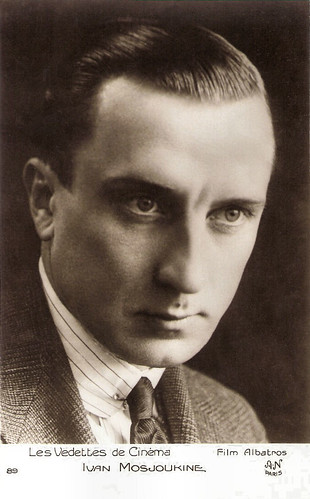
French postcard in the series Les Vedettes de Cinéma by A.N., Paris, no. 89. Photo: Film Albatros.

French postcard by Cinémagazine-Edition, Paris, no. 326. Photo: Studio G.L. Manuel Frères.
After the death of Rudolph Valentino, Ivan Mozzhukhin got a lucrative contract with Universal Pictures. He was cast as a male lead in Surrender (Edward Sloman, 1927).
However, his stint in Hollywood, was not a success, due to numerous pressures from producers who insisted on changing his name to John Moskin and on plastic surgery to shorten his nose.
This operation caused a permanent change in his natural facial expression. In addition to the emotional pains of plastic surgery, and changes to his facial features, he suffered from the lack of chemistry with his non-responsive co-star, Mary Philbin.
At that time Hollywood was already shifting to sound film, and Mozzhukhin, who did not speak English, was not offered any more roles. He returned to Europe.
Artist and longtime friend Aleksandr Vertinsky commented later on Mozzhukhin's suffering in Hollywood, that it was "a conspiracy to destroy the strong competitor".

Austrian postcard by Iris-Verlag no. 574. Photo: Micheluzzi-Film. Ivan Mozzhukhin and Nathalie Kovanko in Michel Strogoff (Viktor Tourjansky, 1926).

German postcard by Ross Verlag, no. 3179/2, 1928-1929. Photo: Albert Witzel, Hollywood, for Universal-Matador.

German postcard by Ross-Verlag, no. 3544/1, 1928-1929. Photo: Roman Freulich. Ivan Mozzhukhin in Surrender (Edward Sloman, 1927).

German postcard by Ross Verlag, no. 5253/1, 1930-1931. On the back of the card: Vendita esclusiva Casa Editrice Ballerini & Fratini, Firenze (125). Photo: Universal. Iwan Mosjukin a.k.a. Ivan Mozzhukhin in Surrender (Edward Sloman, 1927).

German postcard by Ross Verlag, no. 4871/1, 1930. Photo: Ufa. Betty Amann and Ivan Mozzhukhin in Der Weisse Teufel/The White Devil (Alexandre Volkoff, 1930).
The still for the postcard above of Betty Amann and 'Ivan Mosjukin' is from the Ufa production Der Weisse Teufel/The White Devil (1930), based on Leo Tolstoy's 1912 novella 'Hadji Murat'.
With great style and visual flair, Alexandre Volkoff directed this film that represented the European silent tradition at it's finest and most dynamic.
Mozzhukhin stars as a fiery Caucasian captain, Hadscht Murat. His co-stars were Lil Dagover and Betty Amann.
Der Weisse Teufel was his first film to include a synchronised soundtrack: existing of an effective score by Michael Lewin and others, some sequences of singing and whistling, and a range of sound effects, but no dialogue.
Anatole Litvak worked as the film's assistant director and production manager. Another later director, Michael Powell was the stills photographer on the film and probably was the maker of the photo used for the postcards above and below.

British postcard in the Colourgraph Series, London, no. C 79. Photo: Ufa. Ivan Mozzhukhin in Der weiße Teufel/The White Devil (Alexandre Volkoff, 1930).

Austrian postcard by Iris-Verlag, no. 5789. Photo: Pan film A.G. Collection: Didier Hanson.
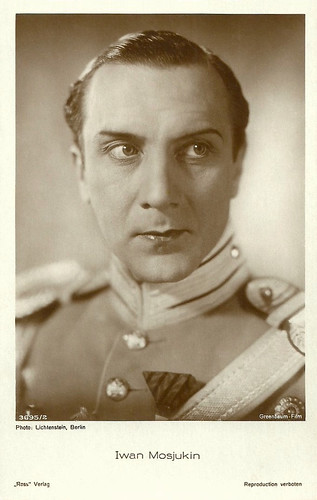
German postcard by Ross Verlag, no. 3695/2. Photo: Lichtenstein, Berlin / Greenbaum Film. Ivan Mozzhukhin in Der Adjutant des Zaren/The Adjutant of the Czar (Vladimir Strizhevsky, 1929).

German postcard by Ross Verlag, no. 3779/1, 1928-1929. Photo: Freulich / Universal-Matador.

German postcard by Ross Verlag, no. 5012/2, 1930-1931. Photo: AAFA Film.
Ivan Mozzhukhin continued to star in sound films like Sergeant X (Vladimir Strizhevsky, 1932), albeit with a smaller success. He moved to France after the rise of the Nazis to power.
His final film was Nitchevo (Jacques de Baroncelli, 1936) with Harry Baur and Marcelle Chantal. By then his filmography included over 100 films made in Russia, France, Italy, United States, Germany, and Austria.
He planned to direct a film in France, but he contracted a severe form of tuberculosis. Ivan Mozzhukhin died in a Neuilly-sur-Seine clinic in 1939. He was laid to rest in the Russian Cemetery at Sainte-Geneviève-des-Bois, a suburb of Paris. All available sources give his age as 49 and year of birth as 1889. However, his gravestone at the Russian cemetery is inscribed with the year 1887.
Mozzhukhin was officially married three times. His first wife was the Russian actress Natalya Lisenko (Nathalie Lissenko). They married in the first half of the 1910s and divorced in 1927. In 1928 Mozzhukhin married Danish actress Agnes Petersen. His third wife was a French actress of Russian origin Tania Fédor, although they were married only for a brief period of time.
His home in Kondol, Russia is now restored as a public Memorial Museum of Ivan Mozzhukhin. Since the 1990s, the museum is having an annual Mozzhukhin film show also known as 'Mozzhukhin's Festivities'.
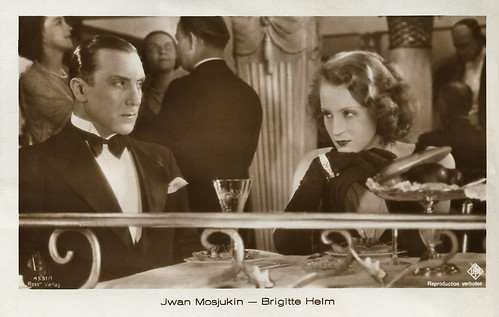
German postcard by Ross Verlag, no. 4531/1. Photo: Ufa. Ivan Mozzhukhin and Brigitte Helm in Manolescu - Der König der Hochstapler/Manolescu, the Prince of Adventures (Viktor Tourjansky, 1929).

German postcard by Ross Verlag, no. 4872/1, 1929-1930. Photo: Ufa. Ivan Mozzhukhin in Der weiße Teufel/The White Devil (Alexandre Volkoff, 1930).

French postcard by Editions P-C, Paris, no. 19. Photo: Adolphe Osso / Gloria Film. Le Choer sang the military march 'Adieu, vieille Europe' in Le Sergent X/Sergeant X (Vladimir Strizhevsky, 1932), starring Ivan Mozzhukhin. Text by Simon Delyon and music by René Mercier and Henri Forterre. Copyright: Editions Salabert, Paris, 1932.
Two clips featured in the documentary Cinema Europe featuring scenes from Kean (1924) and Casanova (1927). Source: Golden Silents (YouTube).
A scene from Der Weisse Teufel/The White Devil (1930), including a vintage soundtrack which was made the same year to fit the film with sound. Source: GoldenSilents (YouTube).
Sources: Steve Shelokhonov (IMDb), Sandra Brennan (AllMovie), Wikipedia, and IMDb.
This post was last updated on 5 August 2020.

German postcard by Ross Verlag, no. 3948/1, 1928-1929. Photo: Ufa. Ivan Mozzhukhin in Casanova (Alexandre Volkoff, 1927).

German postcard by Ross Verlag. no. 1064/3, 1927-1928. Photo: DeWesti Film-Verleih. Ivan Mozzhukhin in Kean ou désordre et génie/Edmund Kean: Prince Among Lovers (Alexandre Volkoff, 1924).

German postcard by Ross Verlag, no. 3179/4, 1928-1929. Photo: Freulich / Universal / Matador. Ivan Mozzhukhin in Surrender (Edward Sloman, 1927).

Austrian postcard by Iris Verlag, no. 5435. Photo: Lux-Film Verleih (Austrian distributor for German film companies, such as Greenbaum-Film, for which Mozzhukhin did various German films). Probably Ivan Mozzhukhin in Der geheime Kurier/The Secret Courier (Gennaro Righelli, 1928), a Greenbaum production.

Austrian postcard by Iris Verlag, no. 5497 Photo: Lux Verleih / G.
Tolstoy and Pushkin
Ivan Ilyitch Mozzhukhin (Иван Ильич Мозжухин in Russian, or Iwan Mosjukin, as he was called in Germany, or Ivan Mosjoukine in France) was born in the village of Kondol, Saratov province, Russian Empire (now Penza province, Russia) in 1889.
His father was general manager of the large estate of Prince Obolensky. Mozzhukhin attended a Gymnasium in Penza, then studied law at the Moscow State University for two years.
At the university, he was active in amateur stage productions. Still a teenager, he joined the popular traveling troupe led by Petr Zarechny. Mozzhukhin became romantically involved with an actress from the troupe, Olga Bronitskaya (born Telegina), Zarechny's sister.
In 1908 she gave birth to their illegitimate son Aleksandr who was registered as the son of Petr Zarechny under his official family name. Thus the boy was raised as Aleksandr Petrovich Telegin, although he was made aware of his real father. According to Telegin, his father always supported them by sending letters, money, and packages until his name came under a ban in the Soviet Union.
Mozzhukhin returned to Moscow where he was a member of the Vvedensky Narodny Dom Theatre. In 1908, Mozzhukhin also made his film debut.
From 1911 to 1914 he worked in the silent films of producer Aleksandr Khanzhonkov. Mozzhukhin shot to fame after his leading role as violinist Trukhachevsky in The Kreutzer Sonata/Kreitzerova sonata (Pyotr Chardynin, 1911), based on the eponymous story by Leo Tolstoy.
He starred as Admiral Kornilov in Oborona Sevastopolya/Defence of Sevastopol (Vasili Goncharov, Aleksandr Khanzhonkov, 1911). This was the first film ever that was shot by two cameras. Next, he appeared in the delightful comedy Domik v Kolomne/The Kolomna House (Pyotr Chardynin, 1913) after a poem by Alexander Pushkin.
He would star in about thirty more silent Russian films made by Chardynin, Khanzhyonkov, and Yevgeni Bauer. His film partners were Diaghilev's ballerina Vera Karalli and his wife Natalya Lyssenko, billed in France as Nathalie Lissenko.

Russian postcard by A. Gornštein, Moscow, 1911.

Russian postcard, no. 1011.

Russian postcard. Collection: Didier Hanson. A Who is Who of the Russian silent cinema. From left to right: Vitold Polonsky, Vladimir Maksimov, Vera Kholodnaya, Ossip Runitsch (in the back), Petr Cardynin, Ivan Khudoleyev, and Ivan Mozzhukhin.

Dutch postcard. Photo: Ivan Mozzhukhin in Pikovaya dama/Pique Dame (Yakov Protazanov, 1916).

Dutch postcard by De Rolprent. Photo: publicity still for Manolescu - Der König der Hochstapler/Manolescu (Victor Tourjansky, 1929) with Dita Parlo.
Numerous Love Affairs
By the mid-1910s, Ivan Mozzhukhin had become the indisputable leading star of the Russian cinema. His facial expressions were studied by many actors and directors as exemplary acting masks.
From 1915 till 1919 he worked in about 40 films by directors Yakov Protazanov and Viktor Tourjansky under the legendary Russian producer Joseph N. Ermolieff.
His best-known films of this period were Pikovaya dama/The Queen of Spades (Yakov Protazanov, 1916) after Pushkin, Nikolay Stavrogin (Yakov Protazanov, 1915) after Fyodor Dostoyevsky, and Otets Sergiy/Father Sergius (Yakov Protazanov, Alexandre Volkoff, 1917).
The reviewer at IMDb writes that Otets Sergiy/Father Sergius "has many uncommonly modern characteristics. Besides the daring subject, it has a rather strongly developed lead character, good storytelling and cinematography, and a script which deals with human emotions without being exploitative or sentimental. Altogether it has a very modern touch to it for a movie made in 1917, (...) a prime example of the art film movement of pre-soviet Russia."
Mozzhukhin's incredible popularity brought him significant wealth, that came with attendant pressure. He also became famous for his numerous love affairs with his admirers.

French postcard by Cinémagazine no. 169. Mozzhukin played the male lead of prince Roundghito-Sing in Le lion des Mogols/The Lion of the Moguls (Jean Epstein, 1924). While the Moghol empire is falling apart, prince Roundghito-Sing decides to leave and make films in Paris, where he falls for the attractions of the city.

German postcard by Ross Verlag, no. 1066/1, 1927-1928. Photo: De Westi Film. Ivan Mozzhukhin and Natalie Lissenko.

German postcard by Ross-Verlag, no. 1265/1, 1927-1928. Photo: Deulig. Ivan Mozzhukhin in Kean ou désordre et génie/Edmund Kean: Prince Among Lovers (Alexandre Volkoff, 1924).

German postcard by Ross Verlag, no. 1512/1, 1927-1928. Photo: Deulig. Nadia Fedor (Nathalie Kovanko) consoles Michael Strogoff (Ivan Mozzhukhin) after he is blinded in Michel Strogoff (1926).

German postcard by Ross Verlag, no. 1510/3, 1927-1928. Photo: Deulig. Ivan Mozzhukhin in Michel Strogoff (Victor Tourjansky, 1926).
Handsome, tall, and possessing a powerful screen presence
In 1918, the Russian Communist Revolution already caused irreversible destruction of cultural and economic life, and Ivan Mozzhukhin moved under the protection of the White Russians in Yalta, Crimea.
Soviet director Lev Kuleshov assembled his revolutionary illustration of the application of the principles of film editing out of footage from one of Mozzhukhin's Tsarist-era films which had been left behind. Mozzhukhin's face in recurring representation of illusory reactions demonstrated in Lev Kuleshov's psychological montage experiment 'the Kuleshov Effect'.
Meanwhile, Mozzhukhin worked for the Ermolieff film company in Crimea. After the Revolution, in early 1920, he left Russia together with his wife Nathalie Lissenko and his partners from Ermolieff. They emigrated together to France and started in Paris a Russian-French film company.
Paris became the new capital for most of the exiled former aristocrats and other refugees escaping the civil war and Bolshevik terror gripping Russia. In France, Ivan Mozzhukhin changed his name into Ivan Mosjoukine.
Handsome, tall, and possessing a powerful screen presence, he won a considerable following as a mysterious and exotic romantic figure. He starred in hits like the innovative murder mystery La maison du mystère/The Mysterious House (Alexandre Volkoff, 1923), Kean/Edmund Kean: Prince Among Lovers (Alexandre Volkoff, 1924), and the lavish adventure spectacle Michel Strogoff/Michael Strogoff (Victor Tourjansky, 1926) based on the Jules Verne novel.
Best remembered is the humourous and visually splendid epic Casanova/The Loves of Casanova (Alexandre Volkoff, 1927). His face with the trademark hypnotic stare appeared on covers of film magazines all over Europe. He wrote the screenplays for most of his starring vehicles and directed two of them, L'Enfant du carnaval/Child of the Carnival (1921) and Le Brasier ardent/The Blazing Inferno (1923).

German postcard by Ross Verlag, no. 1604/2, 1927-1928. Photo: Deulig. Ivan Mozzhukhin in Casanova (Alexandre Volkoff, 1927).

German postcard by Ross Verlag, no. 83/4. Photo: Ufa. Ivan Mozzhukhin and Jenny Jugo in Casanova (Alexandre Volkoff, 1927).

German postcard by Ross Verlag, no. 83/5. Photo: Ufa. Rina De Liguoro and Ivan Mozzhukhin in Casanova (Alexandre Volkoff, 1927). Photo: Société des Cinéromans.

French postcard in the series Les Vedettes de Cinéma by A.N., Paris, no. 89. Photo: Film Albatros.

French postcard by Cinémagazine-Edition, Paris, no. 326. Photo: Studio G.L. Manuel Frères.
Hollywood Conspiracy
After the death of Rudolph Valentino, Ivan Mozzhukhin got a lucrative contract with Universal Pictures. He was cast as a male lead in Surrender (Edward Sloman, 1927).
However, his stint in Hollywood, was not a success, due to numerous pressures from producers who insisted on changing his name to John Moskin and on plastic surgery to shorten his nose.
This operation caused a permanent change in his natural facial expression. In addition to the emotional pains of plastic surgery, and changes to his facial features, he suffered from the lack of chemistry with his non-responsive co-star, Mary Philbin.
At that time Hollywood was already shifting to sound film, and Mozzhukhin, who did not speak English, was not offered any more roles. He returned to Europe.
Artist and longtime friend Aleksandr Vertinsky commented later on Mozzhukhin's suffering in Hollywood, that it was "a conspiracy to destroy the strong competitor".

Austrian postcard by Iris-Verlag no. 574. Photo: Micheluzzi-Film. Ivan Mozzhukhin and Nathalie Kovanko in Michel Strogoff (Viktor Tourjansky, 1926).

German postcard by Ross Verlag, no. 3179/2, 1928-1929. Photo: Albert Witzel, Hollywood, for Universal-Matador.

German postcard by Ross-Verlag, no. 3544/1, 1928-1929. Photo: Roman Freulich. Ivan Mozzhukhin in Surrender (Edward Sloman, 1927).

German postcard by Ross Verlag, no. 5253/1, 1930-1931. On the back of the card: Vendita esclusiva Casa Editrice Ballerini & Fratini, Firenze (125). Photo: Universal. Iwan Mosjukin a.k.a. Ivan Mozzhukhin in Surrender (Edward Sloman, 1927).

German postcard by Ross Verlag, no. 4871/1, 1930. Photo: Ufa. Betty Amann and Ivan Mozzhukhin in Der Weisse Teufel/The White Devil (Alexandre Volkoff, 1930).
White Devil
The still for the postcard above of Betty Amann and 'Ivan Mosjukin' is from the Ufa production Der Weisse Teufel/The White Devil (1930), based on Leo Tolstoy's 1912 novella 'Hadji Murat'.
With great style and visual flair, Alexandre Volkoff directed this film that represented the European silent tradition at it's finest and most dynamic.
Mozzhukhin stars as a fiery Caucasian captain, Hadscht Murat. His co-stars were Lil Dagover and Betty Amann.
Der Weisse Teufel was his first film to include a synchronised soundtrack: existing of an effective score by Michael Lewin and others, some sequences of singing and whistling, and a range of sound effects, but no dialogue.
Anatole Litvak worked as the film's assistant director and production manager. Another later director, Michael Powell was the stills photographer on the film and probably was the maker of the photo used for the postcards above and below.

British postcard in the Colourgraph Series, London, no. C 79. Photo: Ufa. Ivan Mozzhukhin in Der weiße Teufel/The White Devil (Alexandre Volkoff, 1930).

Austrian postcard by Iris-Verlag, no. 5789. Photo: Pan film A.G. Collection: Didier Hanson.

German postcard by Ross Verlag, no. 3695/2. Photo: Lichtenstein, Berlin / Greenbaum Film. Ivan Mozzhukhin in Der Adjutant des Zaren/The Adjutant of the Czar (Vladimir Strizhevsky, 1929).

German postcard by Ross Verlag, no. 3779/1, 1928-1929. Photo: Freulich / Universal-Matador.

German postcard by Ross Verlag, no. 5012/2, 1930-1931. Photo: AAFA Film.
Tuberculosis
Ivan Mozzhukhin continued to star in sound films like Sergeant X (Vladimir Strizhevsky, 1932), albeit with a smaller success. He moved to France after the rise of the Nazis to power.
His final film was Nitchevo (Jacques de Baroncelli, 1936) with Harry Baur and Marcelle Chantal. By then his filmography included over 100 films made in Russia, France, Italy, United States, Germany, and Austria.
He planned to direct a film in France, but he contracted a severe form of tuberculosis. Ivan Mozzhukhin died in a Neuilly-sur-Seine clinic in 1939. He was laid to rest in the Russian Cemetery at Sainte-Geneviève-des-Bois, a suburb of Paris. All available sources give his age as 49 and year of birth as 1889. However, his gravestone at the Russian cemetery is inscribed with the year 1887.
Mozzhukhin was officially married three times. His first wife was the Russian actress Natalya Lisenko (Nathalie Lissenko). They married in the first half of the 1910s and divorced in 1927. In 1928 Mozzhukhin married Danish actress Agnes Petersen. His third wife was a French actress of Russian origin Tania Fédor, although they were married only for a brief period of time.
His home in Kondol, Russia is now restored as a public Memorial Museum of Ivan Mozzhukhin. Since the 1990s, the museum is having an annual Mozzhukhin film show also known as 'Mozzhukhin's Festivities'.

German postcard by Ross Verlag, no. 4531/1. Photo: Ufa. Ivan Mozzhukhin and Brigitte Helm in Manolescu - Der König der Hochstapler/Manolescu, the Prince of Adventures (Viktor Tourjansky, 1929).

German postcard by Ross Verlag, no. 4872/1, 1929-1930. Photo: Ufa. Ivan Mozzhukhin in Der weiße Teufel/The White Devil (Alexandre Volkoff, 1930).

French postcard by Editions P-C, Paris, no. 19. Photo: Adolphe Osso / Gloria Film. Le Choer sang the military march 'Adieu, vieille Europe' in Le Sergent X/Sergeant X (Vladimir Strizhevsky, 1932), starring Ivan Mozzhukhin. Text by Simon Delyon and music by René Mercier and Henri Forterre. Copyright: Editions Salabert, Paris, 1932.
Two clips featured in the documentary Cinema Europe featuring scenes from Kean (1924) and Casanova (1927). Source: Golden Silents (YouTube).
A scene from Der Weisse Teufel/The White Devil (1930), including a vintage soundtrack which was made the same year to fit the film with sound. Source: GoldenSilents (YouTube).
Sources: Steve Shelokhonov (IMDb), Sandra Brennan (AllMovie), Wikipedia, and IMDb.
This post was last updated on 5 August 2020.
No comments:
Post a Comment